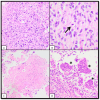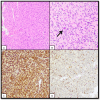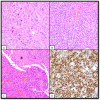Molecular and Pathological Features of Paediatric High-Grade Gliomas
- PMID: 39126064
- PMCID: PMC11312892
- DOI: 10.3390/ijms25158498
Molecular and Pathological Features of Paediatric High-Grade Gliomas
Abstract
Paediatric high-grade gliomas are among the most common malignancies found in children. Despite morphological similarities to their adult counterparts, there are profound biological and molecular differences. Furthermore, and thanks to molecular biology, the diagnostic pathology of paediatric high-grade gliomas has experimented a dramatic shift towards molecular classification, with important prognostic implications, as is appropriately reflected in both the current WHO Classification of Tumours of the Central Nervous System and the WHO Classification of Paediatric Tumours. Emphasis is placed on histone 3, IDH1, and IDH2 alterations, and on Receptor of Tyrosine Kinase fusions. In this review we present the current diagnostic categories from the diagnostic pathology perspective including molecular features.
Keywords: H3G34; H3K27; brain tumour; glioblastoma; glioma; histone 3; paediatric glioma.
Conflict of interest statement
The authors declare no conflict of interest.
Figures




Similar articles
-
Molecular classification of adult diffuse gliomas: conflicting IDH1/IDH2, ATRX, and 1p/19q results.Hum Pathol. 2017 Nov;69:15-22. doi: 10.1016/j.humpath.2017.05.005. Epub 2017 May 23. Hum Pathol. 2017. PMID: 28549927
-
Subgroup characteristics of insular low-grade glioma based on clinical and molecular analysis of 42 cases.J Neurooncol. 2016 Feb;126(3):499-507. doi: 10.1007/s11060-015-1989-5. Epub 2015 Nov 19. J Neurooncol. 2016. PMID: 26586262
-
Molecular investigation of isocitrate dehydrogenase gene (IDH) mutations in gliomas: first report of IDH2 mutations in Indian patients.Asian Pac J Cancer Prev. 2013;14(12):7261-4. doi: 10.7314/apjcp.2013.14.12.7261. Asian Pac J Cancer Prev. 2013. PMID: 24460285
-
New insights into glioma classification based on isocitrate dehydrogenase 1 and 2 gene status.Brain Tumor Pathol. 2011 Jul;28(3):203-8. doi: 10.1007/s10014-011-0050-4. Epub 2011 Jul 7. Brain Tumor Pathol. 2011. PMID: 21735252 Review.
-
Recent updates in pediatric diffuse glioma classification: insights and conclusions from the WHO 5th edition.J Med Life. 2024 Jul;17(7):665-670. doi: 10.25122/jml-2023-0515. J Med Life. 2024. PMID: 39440342 Free PMC article. Review.
Cited by
-
Emerging and Biological Concepts in Pediatric High-Grade Gliomas.Cells. 2024 Sep 5;13(17):1492. doi: 10.3390/cells13171492. Cells. 2024. PMID: 39273062 Free PMC article. Review.
References
-
- Ostrom Q.T., Price M., Ryan K., Edelson J., Neff C., Cioffi G., Waite K.A., Kruchko C., Barnholtz-Sloan J.S. CBTRUS statistical report: Pediatric brain tumor foundation childhood and adolescent primary brain and other central nervous system tumors diagnosed in the United States in 2014–2018. Neuro-oncology. 2022;24:iii1–iii38. doi: 10.1093/neuonc/noac161. - DOI - PMC - PubMed
-
- Mackay A., Burford A., Carvalho D., Izquierdo E., Fazal-Salom J., Taylor K.R., Bjerke L., Clarke M., Vinci M., Nandhabalan M., et al. Integrated molecular meta-analysis of 1000 pediatric high-grade and diffuse intrinsic pontine glioma. Cancer Cell. 2017;32:520–537. doi: 10.1016/j.ccell.2017.08.017. - DOI - PMC - PubMed
-
- Mackay A., Burford A., Molinari V., Jones D.T.W., Izquierdo E., Brouwer-Visser J., Giangaspero F., Haberler C., Pietsch T., Jacques T.S., et al. Molecular, pathological, radiological, and immune profiling of non-brainstem pediatric high-grade glioma from the HERBY phase II randomized trial. Cancer Cell. 2018;33:829–842. doi: 10.1016/j.ccell.2018.04.004. - DOI - PMC - PubMed
-
- WHO Classification of Tumours Editorial Board . Central Nervous System Tumours. (WHO Classification of Tumours Series, Vol. 6) International Agency for Research on Cancer; Lyon, France: 2021. pp. 69–82.
Publication types
MeSH terms
Substances
LinkOut - more resources
Full Text Sources
Medical
Miscellaneous

